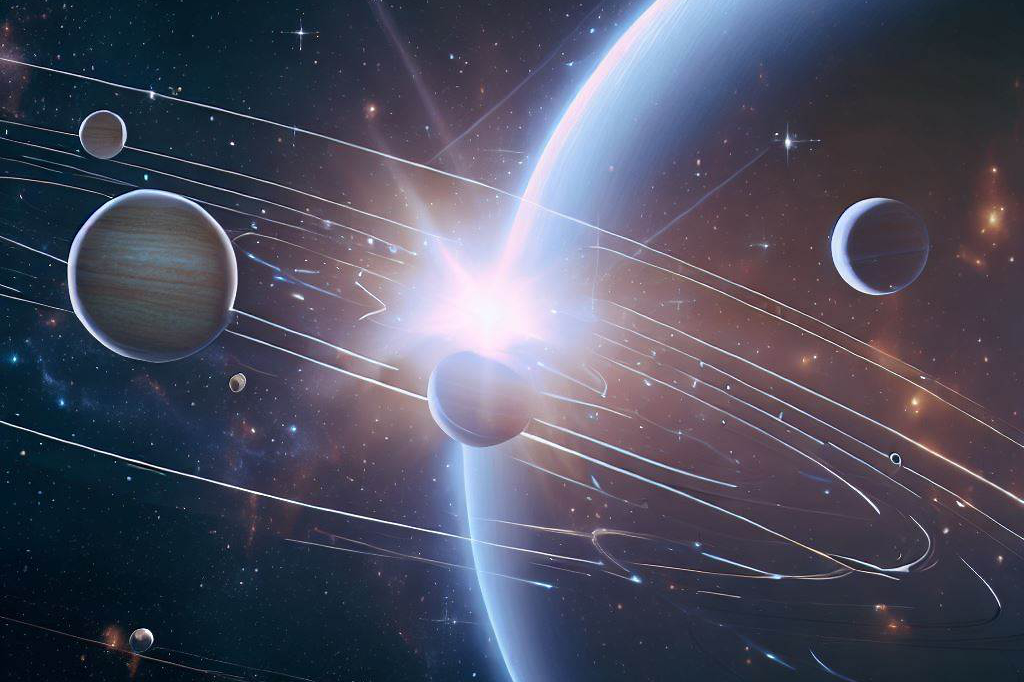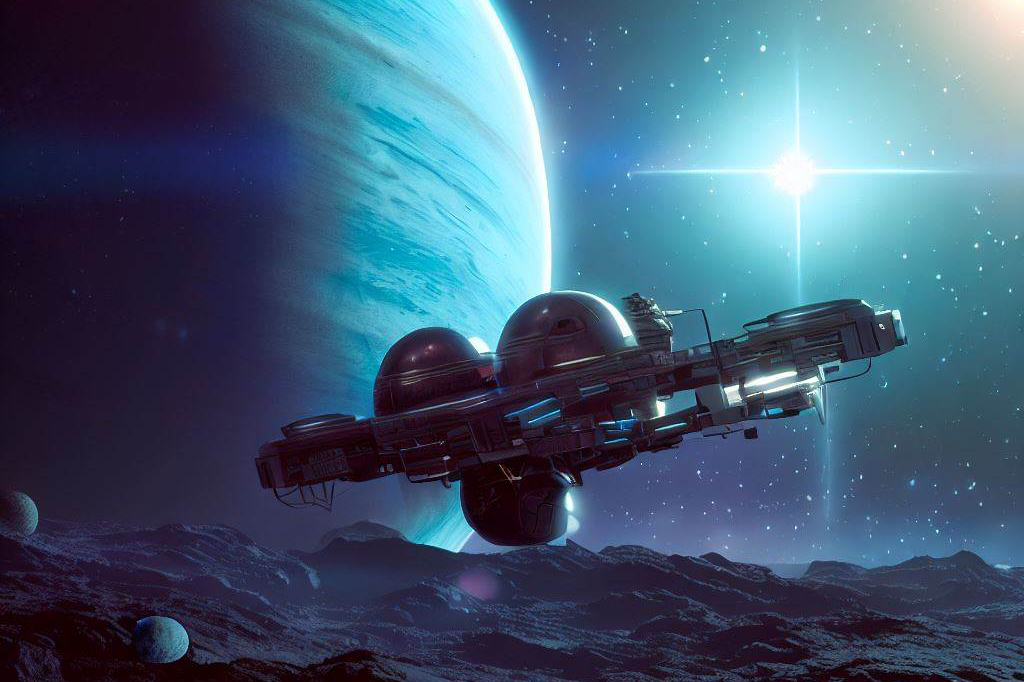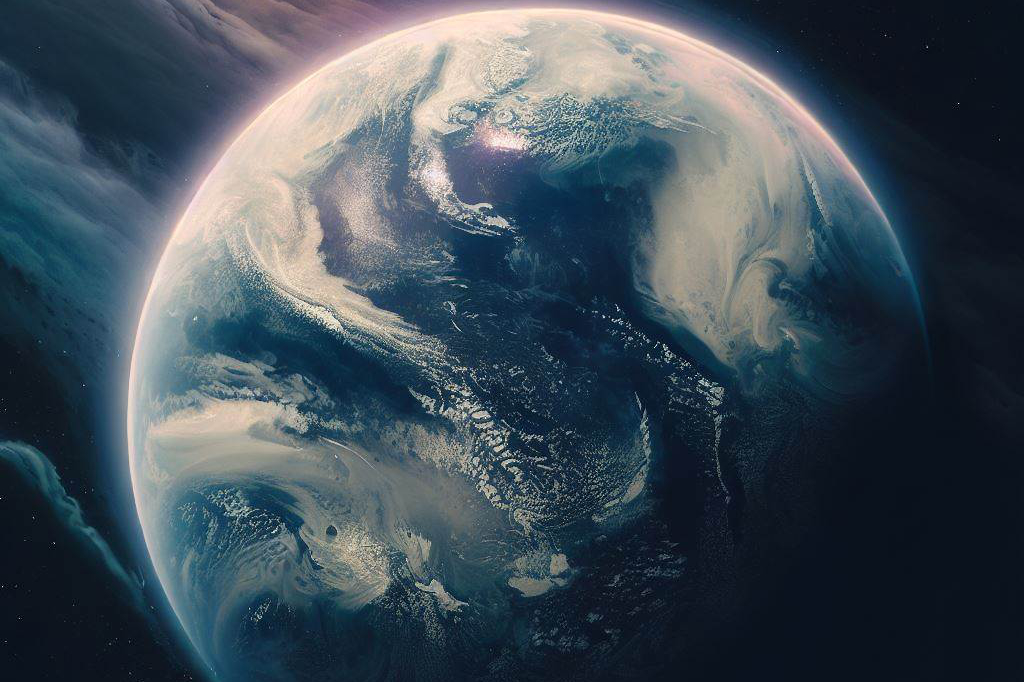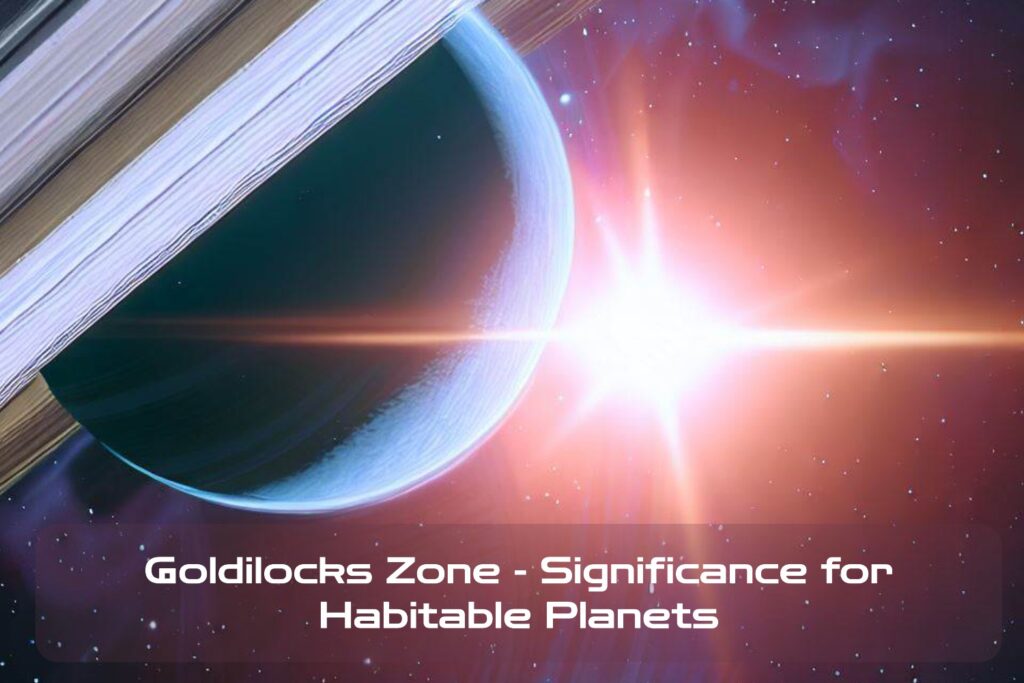The Goldilocks Zone: A Life-Sustaining Sweet Spot
Have you ever heard of the Goldilocks Zone? It’s not referring to the storybook home of the three bears, but rather a special region in space that holds immense importance for astronomers and astrobiologists. The Goldilocks Zone, also known as the habitable zone, is a narrow band around a star where temperatures are just right for liquid water to exist on a planet’s surface.
This sweet spot is not too hot and not too cold, hence the term “Goldilocks,” – just like in the children’s story.

Why is this particular region of space so important?
The answer lies in our search for habitable planets outside of our own solar system. The quest to find life beyond Earth has been an age-old pursuit, but it wasn’t until recent years that we’ve had the technology and resources to actually detect planets orbiting other stars.
However, simply detecting planets isn’t enough – we need to find planets that can potentially sustain life as we know it. And that’s where the Goldilocks Zone comes into play.
Imagine this: You have an indoor plant that needs water and sunlight to grow. If you place it in direct sunlight or completely shade it from any light source, it won’t survive.
Similarly, if you give it too much or too little water, it will wilt and wither away. Life on other planets follows similar rules – they require certain conditions to thrive.
That’s why scientists believe finding planets within the habitable zone increases their chances of harboring some form of life – whether microbial or intelligent. Discovering exoplanets (planets outside our solar system) that have the potential to host life is a thrilling prospect for scientists and space enthusiasts alike.
And while there are many factors at play when determining whether a planet is habitable or not (such as atmosphere, composition, and distance from its star), the Goldilocks Zone is a crucial piece of the puzzle. The search for habitable planets continues to progress, and who knows – maybe one day we’ll find evidence of extraterrestrial life within this special region of space.
Definition and explanation of the concept
The Goldilocks Zone is also known as the “habitable zone.” This region around a star varies depending on its size and temperature, but generally speaking it lies at just the right distance from its host star where temperatures allow liquid water to exist on a planet’s surface. While it’s not guaranteed that every planet within this zone can support life, it’s still considered a critical parameter in determining whether or not we should direct our attention towards studying these planets further.
Factors that determine a planet’s position in the zone

Several factors come into play when determining whether or not a planet lies within its star’s habitable zone. These include:
– The size of the star: smaller stars have cooler surfaces with less intense radiation than larger stars. – The distance between star and planet: closer planets receive more heat from their parent stars while those further receive less heat.
– The type of orbit: circular orbits maintain constant distances from their parent stars while elliptical ones vary in distance. – Atmospheric conditions: the composition and thickness of a planet’s atmosphere can influence how much heat it retains and reflects.
Understanding these factors is essential to determining whether or not a planet lies within the Goldilocks Zone. Despite its simplicity, this concept holds incredible significance when it comes to the search for habitable planets.
Further, the importance of finding habitable planets cannot be overstated.
With the growing threat of climate change and other environmental issues on Earth, it’s becoming increasingly important to explore other options for sustaining human life. By finding planets in the Goldilocks Zone, we can learn more about how planets form and what conditions are necessary for life to flourish.
Explanation of why life needs certain conditions to thrive
Life as we know it requires certain conditions in order to survive. For example, all living organisms need water to live.
Additionally, most organisms require a specific range of temperatures in order to function properly. Too much heat or cold can be deadly for many species.
Another key factor in supporting life is having a stable atmosphere. Earth’s atmosphere contains just the right mixture of gases – primarily nitrogen, oxygen, and carbon dioxide – that allow us to breathe and support plant growth through photosynthesis.
How being in the Goldilocks Zone affects a planet’s ability to sustain life
Being in the Goldilocks Zone greatly increases a planet’s chances of sustaining life because it allows for liquid water on its surface – an essential ingredient for many forms of life as we know it. Additionally, being in this zone means that a planet’s temperature is within a range that allows for vital chemical reactions necessary for biological processes. However, simply being located within this zone does not guarantee that a planet can sustain life.
There are many other factors to consider, such as the planet’s atmosphere and geology. For example, if a planet’s atmosphere is too thin, it will be unable to retain heat, and its surface temperature may fluctuate too much for life to exist.
Overall, the Goldilocks Zone is a key factor in determining whether or not a planet has the potential to sustain life as we know it, but it’s not the only factor.
Examples of Planets in the Goldilocks Zone
The Search for Life Outside Earth

As humans, we have always been curious about the possibility of life outside our planet. The search for extraterrestrial life has led scientists to explore planets that have similar conditions to Earth, such as those in the Goldilocks Zone. While there are many planets that have been discovered within this zone, only a few of them show potential for sustaining life.
Potential Habitable Planets
One such planet is Kepler-452b, which was discovered by NASA’s Kepler spacecraft in 2015. It is located about 1,400 light-years away from Earth and is roughly five times the mass of our planet. The planet orbits a star that is very similar to our Sun and has a year that lasts 385 days.
Scientists believe that it may have liquid water on its surface, which is a crucial element needed for life as we know it. Another potential habitable planet is Proxima b, which orbits Proxima Centauri, the closest star to Earth after our Sun.
It was discovered in 2016 and is roughly 1.3 times the mass of Earth. Its year lasts only 11 days due to its close proximity to its star, but scientists believe that it may be able to sustain liquid water on its surface despite this because it receives much less radiation than other planets close to their stars.
The Challenges of Finding Habitable Planets
While these planets show potential for sustaining life, there are still many challenges scientists face in finding habitable planets. One major challenge is identifying which signals from space are actually coming from planets and not just other sources like stars or cosmic dust. Additionally, even if they do identify a potentially habitable planet like Kepler-452b or Proxima b, they are still unable to see the planet’s surface in enough detail to determine whether or not it is capable of sustaining life.
Despite these challenges, the search for habitable planets and extraterrestrial life continues. With advancements in technology and continued exploration of space, it is possible that we may one day find other life forms beyond our planet.
The Search for Habitable Planets
Overview of current methods used to search for planets in this zone

Scientists have been searching for habitable planets outside of our solar system for decades. They use a variety of methods to detect these planets, including the transit method, the radial velocity method, and direct imaging.
The transit method involves looking at how brightness changes when a planet passes in front of its star.
The radial velocity method looks at the wobbling motion of a star caused by the gravitational pull of an orbiting planet.
Direct imaging involves taking pictures of stars and their surrounding planets.
These techniques have led to the discovery of thousands of exoplanets, many within the habitable zone. However, it is important to note that not all exoplanets detected may be habitable as there are other factors such as atmosphere composition and presence of water that determine habitability.
Future advancements and possibilities
The search for habitable planets is an ever-evolving field, with advancements being made regularly. One exciting possibility is the use of next-generation telescopes such as NASA’s James Webb Space Telescope (JWST) which is able to detect planetary atmospheres and study their chemical makeup. Another approach being explored is using artificial intelligence (AI) to analyze data from telescopes quickly and accurately.
This will help identify potential exoplanets that meet certain criteria, such as those located in the Goldilocks Zone or those with signs of life-supporting conditions. Overall, with continued research and technological advancements, it is hopeful that we will discover more habitable worlds beyond our own in the near future, which could potentially lead us closer to answering fundamental questions about life beyond Earth.
Final Thoughts..
Significance of the Goldilocks Zone

The Goldilocks Zone serves as a reminder that life is fragile and sensitive to its environment. As we continue to explore space and discover new planets, we must be mindful of this fact and recognize the importance of preserving our own planet.
In addition, finding habitable planets could potentially lead to new discoveries in science and technology. It could inspire advances in fields such as medicine, energy, and transportation.
Ultimately, the significance of the Goldilocks Zone lies in its potential to unlock secrets about our universe and ourselves. While much remains unknown, continued exploration may one day reveal answers beyond our wildest imagination.
FAQs
– What is the Goldilocks Zone?
The Goldilocks Zone, also known as the habitable zone, is a region in space around a star where temperatures are suitable for liquid water to exist on a planet’s surface.
– Why is the Goldilocks Zone important?
The Goldilocks Zone is significant because it increases the chances of finding planets that can potentially sustain life as we know it. It plays a crucial role in the search for habitable planets outside of our solar system.
– How does the Goldilocks Zone affect a planet’s ability to sustain life?
Being in the Goldilocks Zone greatly increases a planet’s chances of sustaining life because it allows for the presence of liquid water on its surface. The zone’s temperature range is conducive to vital chemical reactions necessary for biological processes.
– What factors determine a planet’s position in the Goldilocks Zone?
Several factors come into play when determining whether a planet lies within the Goldilocks Zone. These include the size of the star, the distance between the star and the planet, the type of orbit, and the atmospheric conditions of the planet.
– Are all planets within the Goldilocks Zone habitable?
While being within the Goldilocks Zone is a key factor, it does not guarantee a planet’s habitability. Other factors such as the planet’s atmosphere and geology also play a crucial role in determining whether a planet can sustain life.
– Can you provide examples of planets in the Goldilocks Zone?Kepler-452b and Proxima b are examples of potentially habitable planets within the Goldilocks Zone. Kepler-452b, discovered by NASA’s Kepler spacecraft, is located about 1,400 light-years away from Earth and orbits a star similar to our Sun. Proxima b orbits Proxima Centauri, the closest star to Earth after the Sun.
– How do scientists search for planets in the Goldilocks Zone?
Scientists use various methods to search for habitable planets, including the transit method, the radial velocity method, and direct imaging. These techniques involve observing changes in brightness, gravitational effects, and capturing images of stars and their surrounding planets.
– What are the challenges in finding habitable planets?
Identifying signals from planets amidst other sources in space and obtaining detailed surface information are significant challenges. Scientists are constantly developing new technologies and techniques to overcome these obstacles.
– What advancements and possibilities exist in the search for habitable planets?
Next-generation telescopes like NASA’s James Webb Space Telescope (JWST) offer the potential to detect planetary atmospheres and study their chemical makeup. Artificial intelligence (AI) is also being explored to analyze telescope data more efficiently. Continued research and advancements may lead to the discovery of more habitable worlds in the future.
– What is the significance of the Goldilocks Zone?
The Goldilocks Zone reminds us of the delicate balance required for life to thrive. It also has the potential to inspire scientific and technological advancements in various fields and deepen our understanding of the universe and ourselves.
TL;DR…
– 🌍 The Goldilocks Zone, also known as the habitable zone, is a region in space where temperatures are suitable for liquid water to exist on a planet’s surface.
– 🌟 The Goldilocks Zone is important because it increases the chances of finding planets that can potentially sustain life as we know it.
– 💦 Being in the Goldilocks Zone greatly increases a planet’s chances of sustaining life because it allows for the presence of liquid water on its surface.
– 🌟 Several factors determine a planet’s position in the Goldilocks Zone, including the size of the star, the distance between the star and the planet, the type of orbit, and the atmospheric conditions of the planet.
– 🌱 Not all planets within the Goldilocks Zone are habitable; other factors such as the planet’s atmosphere and geology also play a crucial role.
– 🌌 Examples of potentially habitable planets within the Goldilocks Zone include Kepler-452b and Proxima b.
– 🔭 Scientists use various methods to search for habitable planets, including the transit method, the radial velocity method, and direct imaging.
– 🚀 Challenges in finding habitable planets include identifying signals from planets amidst other sources in space and obtaining detailed surface information.
– 🌠 Advancements in technology, such as next-generation telescopes like the James Webb Space Telescope (JWST), offer exciting possibilities for detecting habitable planets.
– 🌎 The Goldilocks Zone has significance beyond the search for habitable planets, reminding us of the delicate balance required for life to thrive

C M, a seasoned editor, journalist, and consultant, is deeply fascinated by the convergence of technology, space, and the future of humanity.
With a particular interest in transhumanity, futurology, and the philosophical and ethical dimensions of these domains, C M serves as the lead contributor to SpaceSpotlight and TranscendSphere.
When not penning insightful articles on these rapidly evolving fields, C M indulges in their love for podcasts and books, proudly embracing their status as a ‘Happy Nerd Extraordinaire!’




Pingback: The Rare Earth Hypothesis and the Search for Life Beyond Our Planet - spacespotlight.com